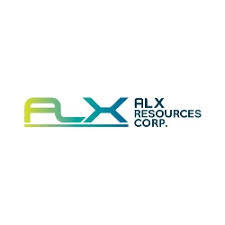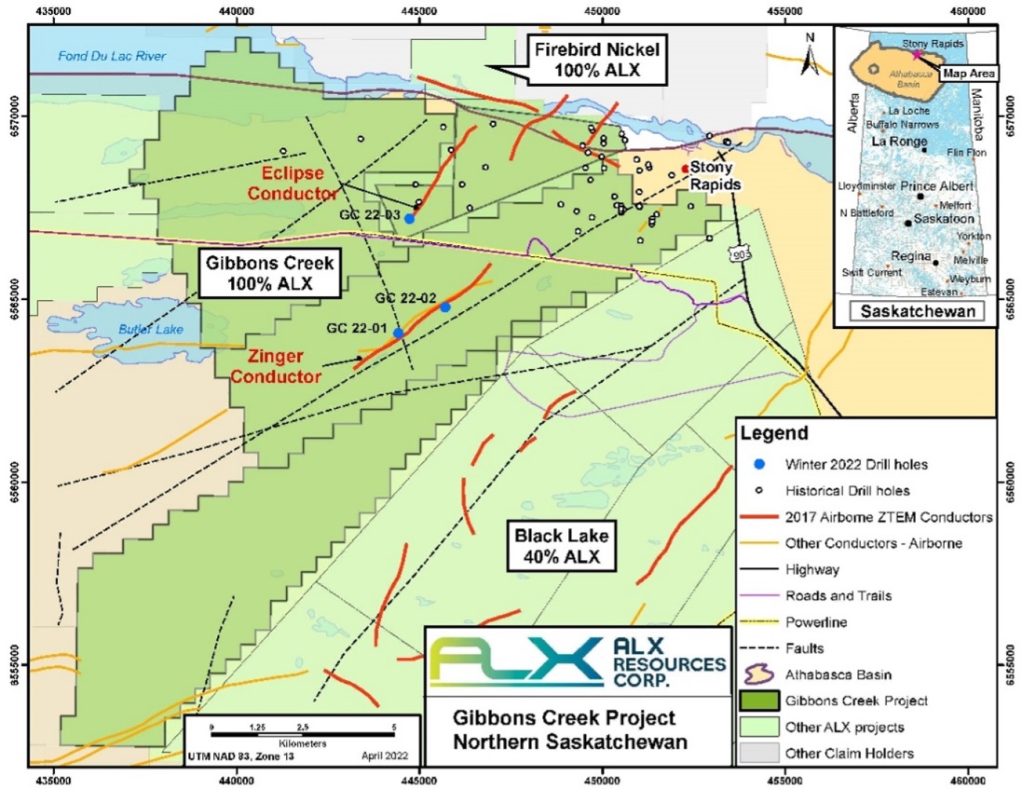
ALX Resources Corp. Receives Drill Results from the Gibbons Creek Uranium Project, Athabasca Basin, Saskatchewan

ALX Resources Corp. (TSX-V: AL) (FSE: 6LLN) (OTC: ALXEF) announced the results of a diamond drilling program carried out in the winter and early spring of 2022 at the Gibbons Creek Uranium Project located in the northern Athabasca Basin near the town of Stony Rapids, Saskatchewan. Three drill holes were completed. for a total of 1,240.3 metres, on two previously untested conductive trends. A total of 262 samples were submitted to the Saskatchewan Research Council Geoanalytical Laboratories in Saskatoon, Saskatchewan. Chip samples were submitted to Rekasa Rocks Inc. of Saskatoon, Saskatchewan for portable Short Wave Infra-Red spectral analysis to determine clay mineral alteration species.
Highlights of the 2022 Drilling Program
- Anomalous uranium values were detected in the Athabasca sandstone in all three drill holes. Ten-metre composite samples returned up to 8.29 parts per million uranium from a partial digestion.
- There were three composite samples in hole GC22-01 (1.46 to 1.63 ppm), six composite samples in hole GC22-02 (1.29 to 8.29 ppm), and three composite samples in hole GC2-03 (1.46 to 3.99 ppm) that are considered anomalous. All of these samples occur in the lower portions of the sandstone.
- The U-p result of 8.29 ppm is approximately 16 times greater than typical background levels of U-p in the Athabasca Group sandstone (approximately 0.5 ppm). The analytical results suggest that uranium-bearing fluids were present in the area of the Gibbons Creek drill holes.
- Statistical analysis also shows that there are anomalous concentrations of the pathfinder elements boron, cobalt, copper, nickel, and lead associated with the anomalous U-p results. These pathfinder elements are commonly used as guides to discovery of unconformity-type uranium deposits and provide further evidence of the presence of fluid movement potentially related to a uranium mineralizing system.
- Elevated gamma probe peaks in drill hole GC22-02 (964 counts per second at 298.36 metres and 1,296 cps at 300.91 m) correlate with mudstone beds that show iron redox alteration patterns around the contacts between the sandstone and the mudstone beds. Selective interval samples over the mudstone beds and at the contacts returned U-p values of 36.1 ppm (298.30 to 298.70 metres) and 21.3 ppm (300.71 to 300.96 metres) over the mudstone beds, and 29.1 ppm (300.96 to 301.46 metres) from the sandstone immediately below the mudstone beds. These results are clear indicators of uranium remobilization by fluid flow in the sandstone.
- Drill hole GC22-01, located along the southwestern portion of the Zinger Conductor, intersected pyrite, siderite, and bleaching high in the sandstone column.
- Sudoite, a chloritic alteration mineral known to be associated with uranium mineralization, was identified by SWIR analysis in the sandstone of drill hole GC22-01 just above the unconformity.
- A zone of moderately graphitic pelitic gneiss was intersected in drill hole GC22-01 between 396 and 400 metres, approximately 41 metres below the unconformity, and is associated with a basement fault.
ALX believes that further drilling is warranted at Gibbons Creek as follow-up to the 2022 drill results and also in the area of historical drill hole GC13-05 located in the eastern part of the Project (0.143% U3O8 over 0.23 metres beginning at a shallow depth of 107.67 metres).
About the 2022 Drilling Program
The 2022 drilling program targeted two untested conductors in a fertile uranium district. The nearby Black Lake Uranium Project (UEX Corporation 50.92% – ALX 40% – Orano Canada 9.08%) located contiguous to Gibbons Creek, hosts graphitic conductors on parallel trends to those present at the Project, which have produced significant uranium occurrences in historical drilling.
In March 2022, ALX prepared winter trails and drill pads on three target areas located along two geophysical conductors: the Zinger Conductor and the Eclipse Conductor. The two conductors were detected in historical airborne surveys and were computer-modelled by the Company’s geophysical consultant to develop new drill targets (see Fig. 1 below).

Fig. 1: Gibbons Creek Uranium Project – 2022 drill hole locations
The southern Zinger Conductor, with 4.7 kilometres of strike length, was first detected by a 2005 MEGATEM survey and confirmed by ALX’s 2017 ZTEM survey. A Spatiotemporal Geochemical Hydrocarbon soil survey, carried out in 2021, outlined two specific areas along the Zinger Conductor that were interpreted as being prospective for uranium mineralization, and are approximately coincident with the locations of drill holes GC22-01 and GC22-02.
A portion of the Eclipse Conductor was first delineated by the 2005 MEGATEM airborne survey, but its full strike length was obscured by the electromagnetic effects of an encroaching powerline. ALX’s Maxwell modeling of the highly-conductive anomaly led to the identification of a new uranium target, tested by drill hole GC22-03.
To view maps and photos of Gibbons Creek click here
About Gibbons Creek
Gibbons Creek consists of seven mineral claims comprising 13,864 hectares (34,259 acres) located along the northern margin of the Athabasca Basin. The Project is located in a region hosting numerous historical uranium occurrences. ALX holds an exploration permit for Gibbons Creek, good until October 2022, which allows for up to 20 diamond drill holes totaling approximately 5,000 metres, along with ground-based geophysics, prospecting, and geochemical sampling. A permit extension application for an additional 18 months has been submitted to Saskatchewan Environment. Access to Gibbons Creek is via roads and trails that lead from the community of Stony Rapids, SK, which is connected to all-weather Highway 905, thereby creating flexibility for either summer or winter exploration programs.
Sampling and Analytical Method and Statement of Qualified Person
The sandstone in all three of the 2022 drill holes was systematically sampled using composite samples collected over 10-metre intervals. Selective sandstone samples were collected from zones of interest, including fracture and alteration zones, as well as within areas of elevated gamma probe results. Continuous systematic sampling was carried out above and below the unconformity. Selective sampling was conducted in the basement rocks over zones of interest, including fracture and alteration zones, and graphitic horizons. ALX regularly inserts duplicates and blank samples into the sample batches, as per industry standards, for quality assurance and quality control (QA/QC) purposes.
Geochemical analyses were carried out by SRC in Saskatoon, Saskatchewan using Inductively-Coupled Plasma Optical Emission Spectrometry (“ICP-OES”) and Inductively-Coupled Plasma Mass Spectrometry (“ICP-MS”) methods. A standard uranium exploration package of analyses (99 analytes in total) were completed, including total digestions utilizing aliquots of pulps prepared from a mixture of concentrated HF:HNO3:HClO4 acids and partial digestions utilizing a mixture of HNO3:HCl acids. Boron is analyzed from an aliquot of a pulp following sodium peroxide fusion. SRC also regularly inserts their own blanks, standards. and repeat analyses into the sample stream for QA/QC purposes. Partial digestions of a sample (e.g. U-p) use a weaker acid digestion than total digestions and are designed to liberate only the more mobile uranium that might be enhanced by hydrothermal fluid circulation. Anomalous uranium analyses from partial digestion are commonly used in uranium exploration because they are more indicative of proximity to uranium mineralization, or uranium-bearing hydrothermal fluid flow.
The technical information in this news release has been reviewed and approved by Robert Campbell, P.Geo., who is a Qualified Person in accordance with the Canadian regulatory requirements set out in National Instrument 43-101.
About ALX
ALX is based in Vancouver, BC, Canada and its common shares are listed on the TSX Venture Exchange, on the Frankfurt Stock Exchange and in the United States OTC market.
ALX’s mandate is to provide shareholders with multiple opportunities for discovery by exploring a portfolio of prospective mineral properties, which include uranium, nickel-copper-cobalt and gold projects. The Company uses the latest exploration technologies and holds interests in over 220,000 hectares of prospective lands in Saskatchewan, a stable Canadian jurisdiction that hosts the highest-grade uranium mines in the world, a producing gold mine, and production from base metals mines, both current and historical.
ALX is an active explorer with interests in a number of uranium exploration properties in northern Saskatchewan, including 100% interests in the Gibbons Creek Uranium Project, the Sabre Uranium Project and the Javelin and McKenzie Lake Uranium Projects, a 40% interest in the Black Lake Uranium Project (a joint venture with UEX Corporation and Orano Canada Inc.), and a 20% interest in the Hook-Carter Uranium Project, located within the uranium-rich Patterson Lake Corridor with Denison Mines Corp. (80% interest) as operator of exploration since 2016.
ALX also owns 100% interests in the Firebird Nickel Project (now under option to Rio Tinto Exploration Canada Inc., who can earn up to an 80% interest), the Flying Vee Nickel/Gold and Sceptre Gold projects, and can earn up to an 80% interest in the Alligator Lake Gold Project, all located in northern Saskatchewan, Canada. ALX owns, or can earn, up to 100% interests in the Electra Nickel Project and the Cannon Copper Project located in historic mining districts of Ontario, Canada, the Vixen Gold Project (now under option to First Mining Gold Corp., who can earn up to a 100% interest in two stages), and in the Draco VMS Project in Norway.
MORE or "UNCATEGORIZED"
Visionary Copper and Gold Mines Inc. Closes Final Tranche of Private Placement Financing
Visionary Copper and Gold Mines Inc. (TSX-V: VCG) (OTCQX: VCGMF) ... READ MORE
PAN GLOBAL STEP-OUT DRILLING EXTENDS LA ROMANA DEPOSIT AT ESCACENA PROJECT, SOUTHERN SPAIN
Highlights include 1.26% copper, 0.01% tin, 2.3 g/t silver over 6... READ MORE
Sorbie Bornholm Announces New Investment of $6,000,000 in Homerun Resources
Sorbie Bornholm LP, a UK investment fund, is pleased to announce ... READ MORE
G2 Goldfields Delivers Maiden PEA for the High-Grade Oko Gold Project
PEA Highlights: High-grade updated resource: Underpinned by G2’... READ MORE
Titan Mining Closes US$15 Million Institutional Financing to Advance U.S. Graphite Strategy
Titan Mining Corporation (TSX:TI) (NYSE-A:TII), an existing zinc ... READ MORE












